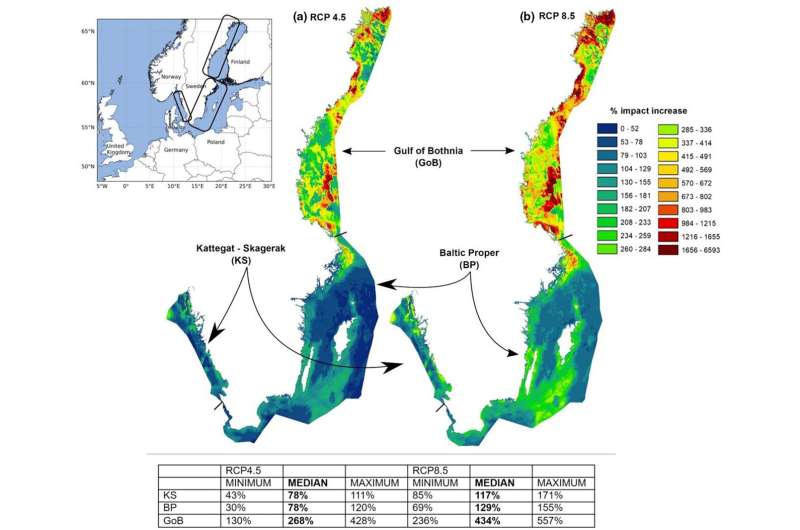Climate change may impact marine environments more than anything else

Promoting the sustainable development of marine environments requires planning, just as we have long had spatial planning for land-based activities. Now researchers from the University of Gothenburg and elsewhere are showing that marine planning must take climate change into consideration—something that it does not currently do. The researchers' models show that changes to temperature and salt content may impact ecosystems and species as much as all other effects on the environment combined.
Symphony is a digital tool that has existed for the past few years. It uses GIS maps that show the distribution of important ecosystems and species along Sweden's coastlines and how by environmental disturbances, such as nutrient pollution, boat traffic and fishing, affect them in different areas. The maps are to guide setting priorities and various measures for public authorities and others that work with marine planning.
One problem with the current version of Symphony is that it does not consider how the climate will change in the future. Now researchers in the ClimeMarine project have studied what happens when the expected changes in temperature and salt content are implemented into the tool.
"It showed that the anticipated climate changes will increase the total environmental impact by at least fifty percent, and in some areas, as much as several hundred percent," says Per Jonsson, researcher at the University of Gothenburg and co-author of the study published in Global Change Biology.
Maps reveal where climate change has the most impact
The GIS maps show how the effects of climate change vary for different areas.
"It's a clear sign that we may need to reduce other impacts to lower the total rate of impact in some areas. For example, in areas with valuable eelgrass meadows, we might consider rerouting a shipping line or slowing the expansion of marinas and leisure boating," says Jonsson.
The tool also enables identification of areas expected to experience less climate impact, such as so-called upwelling areas like off the island of Gotland, where deep cold water rises and cools the water at the surface. Such areas can function as climate refuges, where sensitive species can survive.
"Marine reserves may be considered to protect these areas, where we 'remove' other factors that have an impact. Sweden has committed to establishing several new protected marine areas, and Symphony can help identify where they should be located."
We need more research on how ecosystems and species react
Per Jonsson notes that these types of forecasts naturally have weaknesses. The mathematical models used to calculate future temperatures and salt content are continuously being developed and improved. We also do not know what will happen with our carbon dioxide emissions in the future. This is a political issue that is difficult to assess.
"We also need to better understand how sensitive different ecosystems and species are to climate change. We need experimental studies that show what happens when the temperature rises and salt content decreases."
Even without these, however, he is confident of the impact of climate change for the future of marine environments.
"What we present in the study can be viewed as informed guesses based on the information we currently have. But the effects of a changed climate clearly must be incorporated into marine planning."
More information: Iréne Wåhlström et al, Projected climate change impact on a coastal sea—As significant as all current pressures combined, Global Change Biology (2022). DOI: 10.1111/gcb.16312
Journal information: Global Change Biology
Provided by University of Gothenburg



















